Tiger Hill虎丘英语导游词
苏州虎丘英语介绍
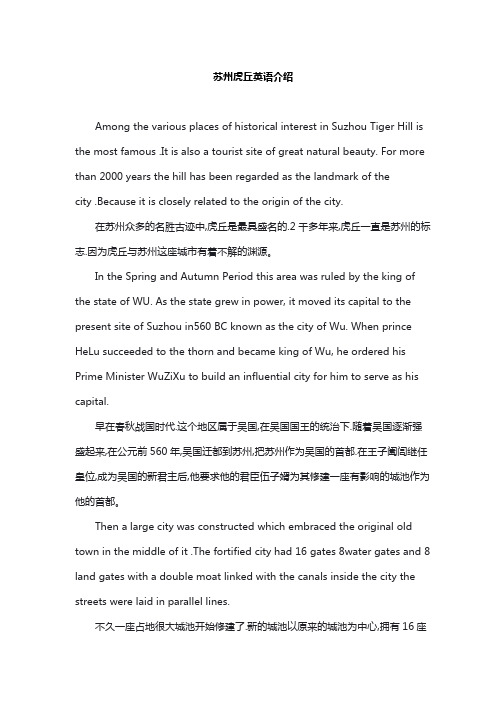
苏州虎丘英语介绍Among the various places of historical interest in Suzhou Tiger Hill is the most famous .It is also a tourist site of great natural beauty. For more than 2000 years the hill has been regarded as the landmark of thecity .Because it is closely related to the origin of the city.在苏州众多的名胜古迹中,虎丘是最具盛名的.2千多年来,虎丘一直是苏州的标志.因为虎丘与苏州这座城市有着不解的渊源。
In the Spring and Autumn Period this area was ruled by the king of the state of WU. As the state grew in power, it moved its capital to the present site of Suzhou in560 BC known as the city of Wu. When prince HeLu succeeded to the thorn and became king of Wu, he ordered his Prime Minister WuZiXu to build an influential city for him to serve as his capital.早在春秋战国时代.这个地区属于吴国,在吴国国王的统治下.随着吴国逐渐强盛起来,在公元前560年,吴国迁都到苏州,把苏州作为吴国的首都.在王子阖闾继任皇位,成为吴国的新君主后,他要求他的君臣伍子婿为其修建一座有影响的城池作为他的首都。
虎丘英语作文
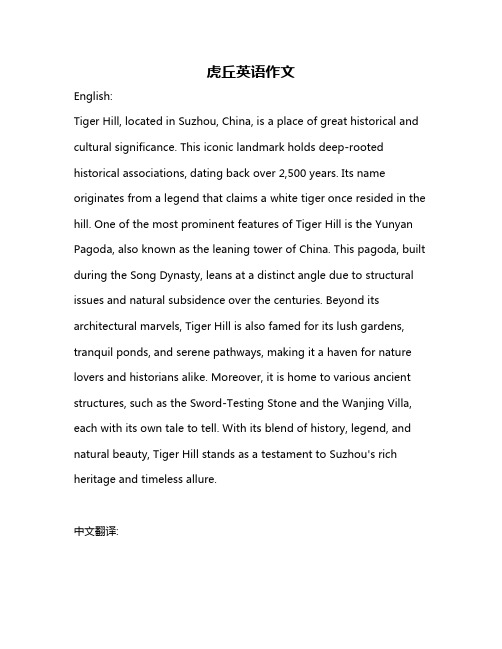
虎丘英语作文English:Tiger Hill, located in Suzhou, China, is a place of great historical and cultural significance. This iconic landmark holds deep-rooted historical associations, dating back over 2,500 years. Its name originates from a legend that claims a white tiger once resided in the hill. One of the most prominent features of Tiger Hill is the Yunyan Pagoda, also known as the leaning tower of China. This pagoda, built during the Song Dynasty, leans at a distinct angle due to structural issues and natural subsidence over the centuries. Beyond its architectural marvels, Tiger Hill is also famed for its lush gardens, tranquil ponds, and serene pathways, making it a haven for nature lovers and historians alike. Moreover, it is home to various ancient structures, such as the Sword-Testing Stone and the Wanjing Villa, each with its own tale to tell. With its blend of history, legend, and natural beauty, Tiger Hill stands as a testament to Suzhou's rich heritage and timeless allure.中文翻译:虎丘位于中国苏州,是一个具有重要历史和文化意义的地方。
虎丘景点用英文写篇作文
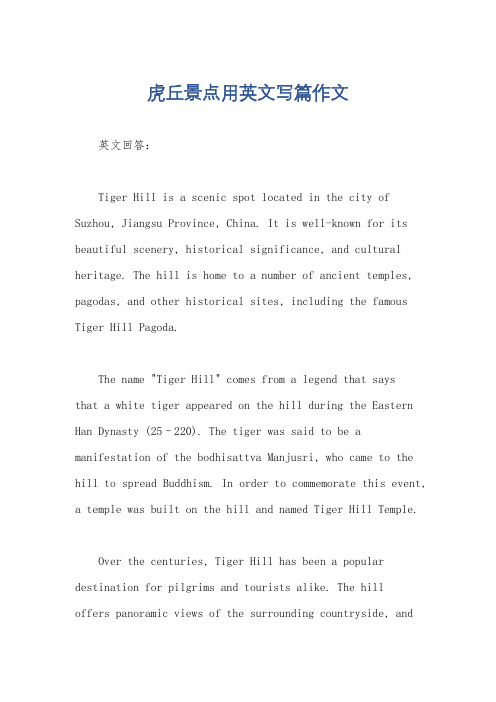
虎丘景点用英文写篇作文英文回答:Tiger Hill is a scenic spot located in the city of Suzhou, Jiangsu Province, China. It is well-known for its beautiful scenery, historical significance, and cultural heritage. The hill is home to a number of ancient temples, pagodas, and other historical sites, including the famous Tiger Hill Pagoda.The name "Tiger Hill" comes from a legend that saysthat a white tiger appeared on the hill during the Eastern Han Dynasty (25–220). The tiger was said to be a manifestation of the bodhisattva Manjusri, who came to the hill to spread Buddhism. In order to commemorate this event, a temple was built on the hill and named Tiger Hill Temple.Over the centuries, Tiger Hill has been a popular destination for pilgrims and tourists alike. The hilloffers panoramic views of the surrounding countryside, andits many temples and pagodas are a testament to the rich history of Chinese architecture.Here are some of the most popular attractions on Tiger Hill:Tiger Hill Pagoda: This is the most famous landmark on Tiger Hill. The pagoda was built in the Song Dynasty (960–1279) and is one of the tallest pagodas in China. It is octagonal in shape and has nine stories. The pagoda is a popular tourist destination, and visitors can climb to the top for stunning views of the surrounding area.Tiger Hill Temple: This is the oldest temple on Tiger Hill. It was built in the Eastern Han Dynasty (25–220) and is dedicated to the bodhisattva Manjusri. The temple is home to a number of important Buddhist relics, including a statue of Manjusri that is said to have been carved from a single piece of sandalwood.Sword Pool: This is a pool of water that is said to have been used by the ancient Chinese general Sun Wu totest his soldiers. The pool is located at the foot of Tiger Hill and is a popular spot for tourists to take photos.Cloud Rock: This is a large rock formation that is located on the side of Tiger Hill. The rock is said to resemble a cloud, and it is a popular spot for tourists to climb and take photos.Tiger Hill is a beautiful and historic place that is well worth a visit. The hill offers stunning scenery, a variety of historical and cultural attractions, and a glimpse into the rich history of China.中文回答:虎丘,位于江苏省苏州市,是著名的风景名胜,以其秀丽的景色、厚重的历史和丰富的文化底蕴而闻名。
虎丘的景点介绍作文

虎丘的景点介绍作文英文回答:Tiger Hill, also known as Huqiu, is a famous scenicspot located in Suzhou, China. It is a place with rich history, stunning natural beauty, and cultural significance. Let me tell you more about this amazing place.First of all, Tiger Hill is renowned for its beautiful landscapes. It is home to various gardens, pagodas, and ponds that create a picturesque setting. One of the most famous attractions in Tiger Hill is the Yunyan Pagoda, also known as the Leaning Tower of China. This seven-story pagoda leans to one side, similar to the Leaning Tower of Pisa, and it has become an iconic symbol of Tiger Hill.Moreover, Tiger Hill is deeply rooted in Chinesehistory and culture. It is believed to have beenestablished over 2,500 years ago during the Spring and Autumn Period. The hill is associated with many legends andstories, such as the burial site of the King of Wu, Helü. The Sword Pool, located at the foot of the hill, is said to be the place where the legendary sword of the King was thrown after his burial.Furthermore, Tiger Hill is a popular destination for tourists and locals alike. It offers a tranquil and serene atmosphere, perfect for relaxation and contemplation. Visitors can take a leisurely stroll through the gardens, enjoy the beautiful scenery, and even have a picnic on the hill. There are also various cultural activities and performances held at Tiger Hill, such as traditional Chinese music concerts and calligraphy exhibitions.中文回答:虎丘,又称为胡丘,是中国苏州市一个著名的风景名胜区。
虎丘英语导游词
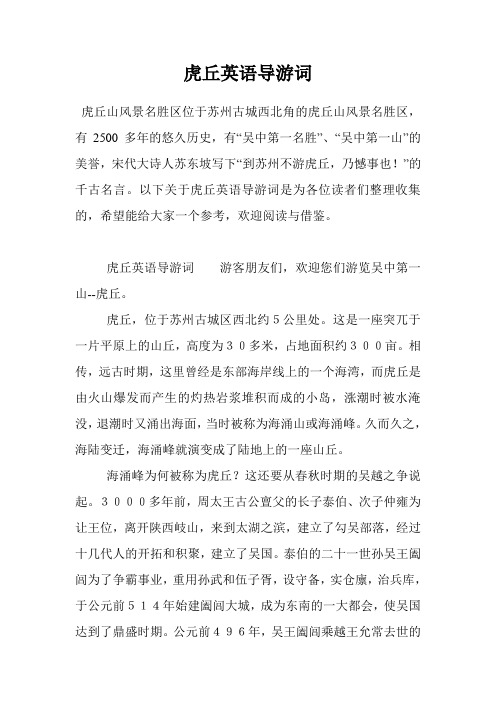
虎丘英语导游词虎丘山风景名胜区位于苏州古城西北角的虎丘山风景名胜区,有2500多年的悠久历史,有“吴中第一名胜”、“吴中第一山”的美誉,宋代大诗人苏东坡写下“到苏州不游虎丘,乃憾事也!”的千古名言。
以下关于虎丘英语导游词是为各位读者们整理收集的,希望能给大家一个参考,欢迎阅读与借鉴。
虎丘英语导游词游客朋友们,欢迎您们游览吴中第一山--虎丘。
虎丘,位于苏州古城区西北约5公里处。
这是一座突兀于一片平原上的山丘,高度为30多米,占地面积约300亩。
相传,远古时期,这里曾经是东部海岸线上的一个海湾,而虎丘是由火山爆发而产生的灼热岩浆堆积而成的小岛,涨潮时被水淹没,退潮时又涌出海面,当时被称为海涌山或海涌峰。
久而久之,海陆变迁,海涌峰就演变成了陆地上的一座山丘。
海涌峰为何被称为虎丘?这还要从春秋时期的吴越之争说起。
3000多年前,周太王古公亶父的长子泰伯、次子仲雍为让王位,离开陕西岐山,来到太湖之滨,建立了勾吴部落,经过十几代人的开拓和积聚,建立了吴国。
泰伯的二十一世孙吴王阖闾为了争霸事业,重用孙武和伍子胥,设守备,实仓廪,治兵库,于公元前514年始建阖闾大城,成为东南的一大都会,使吴国达到了鼎盛时期。
公元前496年,吴王阖闾乘越王允常去世的机会,亲自率兵攻打越国。
由于阖闾骄傲轻敌,中了越王勾践的埋伏,在槜李地区受伤,回师途中在嘉兴去世,归葬海涌山。
这段历史,在唐代陆广微先生撰写的《吴地记》上是这样记载的:海涌山在吴县西北九里二百步,阖闾葬此山中。
发五郡之人作坟,铜椁三重,水银灌体,金银为坑。
《史记》云:’阖闾坟在吴县阊门外,以十万人治坟,取土临湖葬。
经三日,白虎踞其上,故名虎丘山。
’《吴越春秋》云:’阖闾葬虎丘。
十万人治葬,经三日,金精化为白虎蹲其上,因号虎山。
自此以后,虎丘就成了苏州的一大名胜。
千百年来,无数英雄豪杰、文人雅士凭借着虎丘这个舞台,演出了许多威武壮丽的史剧,从而留下了无数的宝贵遗迹,增添了浓厚的传奇色彩。
虎丘英文导游词
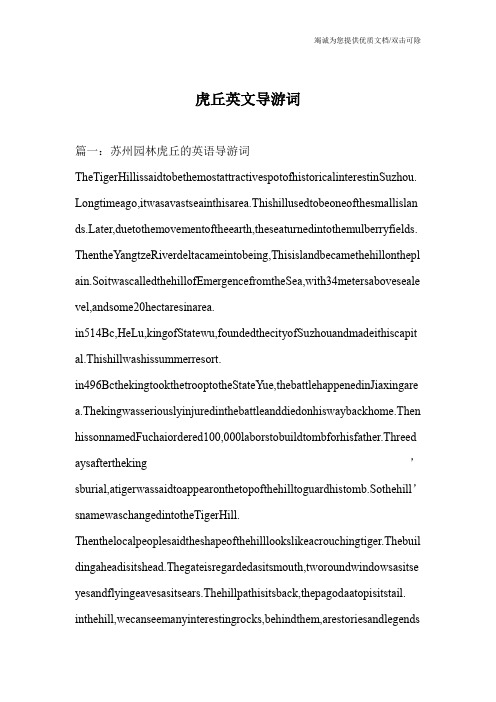
虎丘英文导游词篇一:苏州园林虎丘的英语导游词TheTigerHillissaidtobethemostattractivespotofhistoricalinterestinSuzhou. Longtimeago,itwasavastseainthisarea.Thishillusedtobeoneofthesmallislan ter,duetothemovementoftheearth,theseaturnedintothemulberryfields. ThentheYangtzeRiverdeltacameintobeing,Thisislandbecamethehillonthepl ain.SoitwascalledthehillofEmergencefromtheSea,with34metersaboveseale vel,andsome20hectaresinarea.in514Bc,HeLu,kingofStatewu,foundedthecityofSuzhouandmadeithiscapit al.Thishillwashissummerresort.in496BcthekingtookthetrooptotheStateYue,thebattlehappenedinJiaxingare a.Thekingwasseriouslyinjuredinthebattleanddiedonhiswaybackhome.Then hissonnamedFuchaiordered100,000laborstobuildtombforhisfather.Threed aysaftertheking’sburial,atigerwassaidtoappearonthetopofthehilltoguardhistomb.Sothehill’snamewaschangedintotheTigerHill. Thenthelocalpeoplesaidtheshapeofthehilllookslikeacrouchingtiger.Thebuil dingaheadisitshead.Thegateisregardedasitsmouth,tworoundwindowsasitse yesandflyingeavesasitsears.Thehillpathisitsback,thepagodaatopisitstail. inthehill,wecanseemanyinterestingrocks,behindthem,arestoriesandlegendsoftheking.Themostfamoushighlightisthepagoda,itisknownastheleaningpag odaofPisainchina. ThefamouspoetSudongpointheSongdynastyonceremarked,“TovisitSuzhou withoutseeingtheTi gerHillwouldbeathingforregret.”HereistheBridgeofEmergencefromtheSea.in1956,whenthehillmoatwasdre dgedthebridgewasbuilt,anditwasbuiltofgranite.wecansee12lovelystonecar vedlionsontherailingsofthebridge,theyarevividandlifelike.Thelionsculptur eisasymbolofauspiciousinchina. ThesecondentrancehallisalsocalledtheBrokenBeamHall.inthehillthereareo nlytwothingswhichareoriginal,oneisthishall,andtheotheristhepagoda.Thish allwasbuiltintheYuandynasty(1279-1368)some700yearsago.Sincethemain beamismadeoftwologslookinglikeabrokenbeam,sothat’swhywecallittheBrokenBeamHall. Undertheroofaroundthebuildingarethebracketsets,theybeartheweightofther oofandscattertheweightontothegroundthroughthosecolumns,sowesaidthew allsofthebuildingdon’tbearweight,ifyoumovethemaway,thebuildingwillnotfalldown.allthejoints ofthewoodenstructurewereconnectedwiththetraditionaltenonsandmortises, withoutasinglenail.That’swhythebuildinghasbeenkeptsolong.itisregardedasamasterpieceofclassical architecture. Thewoodentabletfacingthesouthhaswithfourbigchinesecharactersonit,whichmeans“Thewell-knownplaceofinterestinSuzhou”.Thefourcharactersont heotheronefacingthenorthmean“containingtherealandhidingtheancient.”T hatis,therealhill,realwater,realpersonsandrealdeeds,andtheancientpagoda,a ncienttemple,ancientspring,andancienttombinthehill. ThefamousSword-TestingRockisabigovalrock.itiscleftinthemiddleasthoug hbyasword.Legendhasitthatacouple,Ganjiangandmoye,wereskillfulsword-smiths.Theywereforcedbythekingtoforgethesharpswordsforhim.Thecoupl ehadquietafewexperimentsand finallysucceededinforgingtwoswords.afterthekinggotoneofthem,hecamehe retotestwhetheritwassharp.downcamethesword.Therocksplitintwo,sothat’swhycalledSwordTestingRockinthelaterdynasties,alotofliteratisandmenofliteraturecametovisittheTigerHi ll,theysighedandpraisedabouttheswordwhentheysawtherock. SoonthestonewecanstillseeapoemwrittenbyGuYingintheY uandynasty,whi chgoes“whiletheswordwastested,therockwascleft,thecleffellandblockedth ebrook.why,hundredsofyearslater,wasitnotusedtodecapitatethesinistereunu chzhaoGao?”ThelegendoftheswordissimilartoExcalibur,Kingarthur’ssword. alittlefurtherontheleftisthePillowStone,whichwassaidtohavebeenusedforth atpurposebythemonkmr.ShengGong.ShenGongwasafamoushighrankingm onkintheEastJindynasty.HehadhisnewBuddhisttheorythatthosewhohaveth esenseofBuddhismwouldallbecomeBuddhist.Forhistheorywasagainstbyothermonks,hewasdrivenoutofthecapitalofthecountry,andthenhetraveledtoev erywhere.onedayhecametotheTigerHillforpreaching.Herestedonthisstonea sapillowwhenhewastired.Hencethename.HereistheThousand-manRock,afterkingwasburied,hissonFuchai,thenewki ng,orderedtokillallthetomb-buildersheretokeepthetomb’ssecret.Theirbloodstainedtherock,evennow,afterraining,therockstillappear sreddish.inchinese,Thousanddoesn’tmeanonethousand,whichmeansalot. ThePlatformformr.ShengGong,intheJindynasty,thefamoushighrankingmo nkmr.ShenGongoncepreachedhere.alotofbelievers(worshipers)gotheretoli stentohispreaching.whathepreachedwassoexcellentthatallthelistenerskeptn oddingtheirheadstoexpresstheirapproval.Eventhehardrockinthepondwasm ovedbyhispreachingandnodded.SotodaywecanstillseethenoddedRockinthe Pond.Twoimmortal’sPavilion,itisassociatedwithtwoTaoistimmortals,LuchunyangandchenTua n,theyonceplayedchinesechesshere.Thepavilionismadeofstone,itsroofwas nicelycarvedfromonesinglepieceofstoneintheearlyQingdynasty.insidethere aretwostonetabletsshowingtheirportraits. Thefourbigcharactersinredis“TigerHill’sSwordPond”,thisgreathandwritingwasoriginallywrittenbyYanzhenqin,an otedcalligrapherintheTangdynasty(618-907).afterthetimewentby,twocharacters“TigerHill”felldown,andthenwasrewrittenbyzhangzhongyuinQingdy nasty.Sohereisasayingthat:realSwordPond,pseudoTigerHill. SituatedeastofthewhiteLotusPondare53steps,whichareaneatflightofgranite stonestepsleadinguptothemainhallofcloud-RockTemple.Thesestepscanbef oundintheB uddhistsaying:”climb53stepstopaytributetoBuddha.”according toBuddhism,theBoyofTreasuresworshipped53bodhisattvasashisteacher.So 53stepscanbeseensometimesnearBuddhisttemplesinhillyarea. nowwearrivedatthecloud-RockTemple.duringtheculturerevolution,thetem plewasdamaged,allstatuesinsideweredestroyed,thepresentthreestatuesrestoredlate r.inthemiddleisastatueofSakyamuni.Hewasaprinceofasmallkingdombeside nepal.whenhesawthecitizenssufferingfrombirthanddeath,sicknessandaging ,,hegaveuphisluxuriouslifeandwenttoforesttothinkdeeply.after6yearsmedit ation,hewassuddenlyenlightened,,andthenbecame theBuddhaandthePatriarch. onthebothsidesinfrontofstatuearetwodisciples.Theyoungeronenamedanaw ashiscousin.HehadfollowedSakyamuniforover20yearsandhehadgoodmem ories.HehadkeptalltheteachingsandallinstructionsfromSakyamuniinhismin d,recitedthemandcopiedthemonthebodhileavesafterSakyamunipassedaway ,whicharetheBuddhistsutraswecanseetoday.TheelderonewasJiashe,oncepr esidedoveragatheringinLinjiumountain,attendedby500indianmonksafterS akyamunidied.。
虎丘的景点介绍英语作文

虎丘的景点介绍英语作文English Answer:Tiger Hill, also known as Yuantouzhu, is a scenic spot located in the northwest of Suzhou, Jiangsu Province, China. It is one of the most famous tourist attractions in Suzhou, and is known for its beautiful scenery and historical significance.The hill is 36 meters high and covers an area of about 15 hectares. It is divided into two parts, the east andwest peaks. The east peak is higher than the west peak, and is home to the famous Tiger Hill Pagoda. The west peak is home to the Yunyan Temple and the Huqiu Tower.The Tiger Hill Pagoda is the most famous landmark on Tiger Hill. It is a seven-story octagonal pagoda, which was built in the Song Dynasty. The pagoda is 47 meters high and has a diameter of 10 meters. It is made of brick and wood, and is decorated with exquisite carvings.The Yunyan Temple is a Buddhist temple which was built in the Tang Dynasty. The temple is home to a large number of Buddhist statues, and is a popular place of pilgrimage for Buddhists.The Huqiu Tower is a nine-story wooden tower which was built in the Ming Dynasty. The tower is 45 meters high and has a diameter of 12 meters. It is made of wood and is decorated with exquisite carvings.In addition to its historical significance, Tiger Hill is also known for its beautiful scenery. The hill is surrounded by trees and flowers, and offers stunning views of the surrounding area. The hill is also a popular spotfor birdwatching, and is home to a variety of bird species.Tiger Hill is a popular tourist destination, and is a must-see for any visitor to Suzhou. The hill is easily accessible by public transportation, and there is a variety of shops and restaurants in the area.中文回答:虎丘,又名元头渚,位于江苏省苏州市西北部,是中国著名的旅游胜地之一,以景色秀美,历史悠久而闻名。
虎丘英文作文小学

虎丘英文作文小学Tiger Hill is a famous tourist attraction in Suzhou, China. It's a beautiful place with a lot of history and culture.I went to Tiger Hill with my family last summer. We hada great time exploring the gardens and the ancient pagoda. The views from the top of the hill were amazing, and wetook a lot of photos.The history of Tiger Hill is really interesting. There are a lot of old stories and legends about the hill, andit's fun to learn about them while you're there. Theleaning pagoda is especially cool to see.The gardens at Tiger Hill are so peaceful and beautiful. There are a lot of different plants and flowers, and it's a great place to relax and enjoy nature. We spent a lot of time just walking around and taking in the scenery.The food at Tiger Hill is also really good. We tried some local snacks and dishes, and everything was delicious. It's a great way to experience the local cuisine whileyou're visiting.Overall, Tiger Hill is a must-see if you're ever in Suzhou. It's a beautiful and historic place that has something for everyone to enjoy. I'm so glad we got tovisit and experience it for ourselves.。
- 1、下载文档前请自行甄别文档内容的完整性,平台不提供额外的编辑、内容补充、找答案等附加服务。
- 2、"仅部分预览"的文档,不可在线预览部分如存在完整性等问题,可反馈申请退款(可完整预览的文档不适用该条件!)。
- 3、如文档侵犯您的权益,请联系客服反馈,我们会尽快为您处理(人工客服工作时间:9:00-18:30)。
Tiger Hill概述——海涌桥——断梁殿——试剑石——枕石The Tiger Hill is accepted as the most attractive place of historical interest in Suzhou.Thirty-four meters above sea level, and some 20 hectares area, it used to be called the Hill of Emergence from the Sea .It is the burial place of He Lv, kIng of State Wu, Who founded the city of Suzhou in 514 BC and made it his capital. Historical records said that 496BC, When the king of Yue passed away. King He Lv wanted to seize the chance and intended to attack State Yue. The army of two states engaged at Zui Li of Jia Xing city. Because King He Lv’s underestimate, he was injured then died in the way back. His son Fu Chai conscripted more than 100 thousand labors to build the tomb in the Tiger Hill. Three days after his burial, it is said a tiger appeared on the top of the hill to guard the tomb, hence it named tiger hill. The local people said the hill is in the shape of a crouching tiger, the Broken Beam Hall is its head,( the gate is its mouth, two round windows its eyes,) hill path its back, the pagoda on the top of the hill is its tail. In the hill are some interesting stones such as Sword Testing Rock, Pillow Rock, Thousand Man Rock, Nodding Rock and so on. Each of them has stories and legends. Then the most famous highlight is the pagoda on the top. It is known as the leanin g tower of “Pisa” in Chinese. Tiger hill is known as the No.1 famous hill in Wu aera. No wonder the prominent poet Su Dongpo in Song dynasty remarked, “To visit Suzhou without seeing the tiger hill would be a thing for regret.”Here is the Bridge of Emergence from the Sea. The bridge got its name because it is said that it ancient china here is a sea, and this hill used to be one of the small islands, but with the time passing, here becomes plain and only this island left that is nowadays Tiger Hill. The bridge is made of the granite, produced of Suzhou. On the railings of both sides are 12 lions- the 6 males their paws are embroidered balls which symbolize the power, other 6 females with baby lions under their paws, which means the endless offspring one generation after another.This entrance hall is named the Broken Beam Hall. It gets its name because the main beam of the hall is made of 2 logs not joined in the middle. Under the eaves are bracket sets. Bracket sets bear the weight of the roof, and scant the weight through the post in the walls, walls of thebuilding bear no weight, if the walls are removed, the build will not fall down. All the joints of the wooden structure are fastened with the traditional tenons and mortises without a single metal nail. So the building can kept so long years. Under the roof of the hall there are two wooden tablets, on which are written four big characters each. Those facing south mean “the historical site famous in Kingdom Wu” and those facing north mean “containing the real and hiding the ancient.”The famous Sword-Testing Rock is a big oval rock. It is cleft in the middle as though by a sword. Legend has it that this is the place where King He Lv tried out his precious sword. The story goes that He Lv, King of State Wu employed hundreds of foundry men to cast several thousand sharp swords for his army. Hearing that the couple, Ganjiang and Moye, were skillful sword-smiths, he ordered them to cast a pair of swords for his personal use. The husband and wife forged a pair of swords which were made of alloy that steel. One was called Ganjiang, the other was named Moye. Ganjiang presented Moye sowrd to King Wu, and hid another one himself. One day the King came to this hill and tested the sword on this rock. Down came the sword. The rock split in two as if it were mud. This rock is said to be today’s Sword-Testing Rock on the Tiger Hill. By the side of the Sword-Testing Rock there is an ancient poem engraved on a cliff, which means:”While the sword was tested, the rock was cleft, the cliff fell and the brook was blocked. Why, hundreds of years later, was it not used to decapitate the sinister eunuch Zhao Gao?”A little further on the left is the Pillow Stone, which was said to have been used as the pillow by the monk Sheng Gong. Shenggong was a learned Buddhist monk in the Jin Dynasty around the 3rd and 4th centuries. He put new theory “those who have the sense of Buddhist can all become buddhas. His theory was opposed by those old school. And then his travelled in China, finally he settled down in the temple on SanTang street, he came to the hill to preach. Many believers gathered the hill to listen to the preaching. What he said was so excellent that all the listeners kept nodding to express their approval, even hard rock in the tomb was moved to nod. When tired of preaching, he would come to this stone and lie down for a rest with the stone as his pillow.千人石——生公讲台(点头石)——二仙亭——“虎丘剑池”石刻——剑池Here is the Thousand-Man Rock, a huge rock resembling a terrace. It is said that Fu Chai made labors build his father Helv’s grave, after the completion. He ordered to kill all the tomb builders here to keep the tomb secret, the blood of these builders stained this huge rock. Today the blood stains can still be seen on the rock, which looks reddish especially after rain.However, another story has it that the monk Shenggong lectured here some 1600 years ago. Shenggong was a learned Buddhist monk in the Jin Dynasty around the 3rd and 4th centuries. He put new theory “those who have the sense of Bud dhist can all become buddhas. His theory was opposed by those old school. And then his travelled in China, finally he settled down in the temple on SanTang street, he came to the hill to preach. No less than a thousand listener sit here to listen to the pr eaching. So the Rock also called the Sheng Gong’s Rostrum.On the northeast side of the Rock lies a pond, known as the White Lotus Pond. Located in the middle of the pond is the Nodding Stone. It acquired this name because Monk Sheng Gong, who has lectured persuasively enough to make the rocks nod in agreement. This rock in Pond is supposed to be one of those nodding stones.Here is the Two Immortals’ Pavilion. It is associated with two Taoist immortals, Lv Chunyang and Chen Tuan. Its roof was nicely carved from one single piece of granite. Inside, there are 2 stone tablets showing their portraits.Tourists like very much to have photo taken in front of the four big characters in red meaning Tiger Hill’s Sword Pond. This marvelous handwriting was written by Yan Zhenqin the calligrapher in Tang Dynasty. With the year goes by, the characters “Hu Qiu” means TigerHill,were ruined. In Ming Dynasty, the local calligrapher Mr. “Zhang Zhongyu” rewrited the characters “Hu Qiu”. Popular saying is like that:”real sword pond, pseudo tiger hill”.Go through the circular gate called “Another Wonderland”, here is the Sword Pond. The pond is in the shape of a sword without handle. On the left cliff are two Characters said to be handwriting by Wang Xizhi. The 4 characters now facing us mean “Windy ravine and clouds spring” written by Mi Fu. According to history, King He Lv liked collecting swords. When he was buried, 3000 swords were buried, too. In the following dynasty, people came here and tried to find his tomb toget the treasure. In 221 BC when the first Emperor “Qin Shihuang” unified the China. He ordered a lot of soldiers to dig the tomb here. But they failed because the water gushed out from spring underground. In 1955 when the pagoda was repaired, the local government had Sword Pond dredged. After digging, the workers found a triangular entrance at the bottom of the pool, enter 10 metres, one have to turn to the left, there the workers saw 4 huge rectangular stone slabs, one lay on the ground as the base, the other 3 were piled up in a triangle. It is said it was the real entrance to the tomb. But this place happened to be under the pagoda. In order to avoid affecting the foundation of the pagoda, excavation of the tomb had to be stopped. Now the tomb is still a mystery.五十三参——云岩禅寺大殿——云岩寺塔To the east of the White Lotus Pond are 53 steps, which are a neat flight of granite stone steps leading up to the mahavira hall of Cloud Rock Temple. Their significance can be found in the Buddhist saying:” Climb 53 steps to pay tribute to Buddha.” According to Buddhism, the Boy of Treasures, who is the attendant for the Bodhisattva of Compassion, worshipped 53 Bodhisattvas as his teachers. So sometimes you can see 53 steps near the Buddhist temples in hilly areas.At the end of the 53 steps is the mahavira hall. In the hall, the Sakyamuni is face to us, and the Kasyapa and Ananda stand each side by him. The picture of Eighteen Arhats are hung on the wall around the hall.Popularly known as Tiger Hill Pagoda, the Cloud Rock Temple Pagoda on top of the Hill is a leaning pagoda with 7 stories and an octagonal base. The pagoda is 47.7 metres high. Because its foundation ploblem, it began to lean toward Northeast in Yuan Dynasty. In 1956,when it was repaired, workers found a lot of Culture relics. Among them is a stone casket. In the casket is a scripture box, contain 7 volume Buddhist sutra. At the bottom of the box, they saw dates of the construction, began to build from 959 AD and completed in 961AD. In 1982, lots of cracks appeared on the wall of pagoda, the situation is very dangerous. The famous architects are called to discuss the way of maintenance. Finally they decided to take 4 steps to repair it. First of all, 44 cement posts 1.1 metres in diameter each were made round the pagoda base, and a concrete ringwas constructed to link all 44 posts. Secondly, poured in ciment paste to fill in the gaps under and round the pagoda. And 161 holes were dug around pagoda in order to fill the paste. Thirdly, A special technique was used to ma ke a huge cement plate base to support the pagoda’s bottom. Fourthly, to replace those eroded bricks of the pagoda. Now the pagoda stops its leaning. The central axis now is 2.34 meters away from its original central axis, form a lean angle of two degrees 48 minutes. Now, being the symbol of Suzhou, Tiger Hill pagoda is a treasure not only in Suzhou but also throughout China. The pagoda has been shown on a stamp of New China.。
